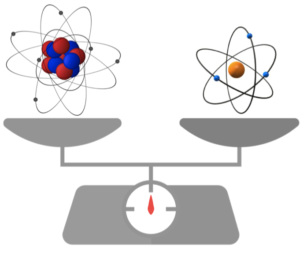How do you weigh an atom?
As mentioned in the earlier sections, the mass of an atom is measured on the unified atomic mass unit scale. This is carried out in a mass spectrometer with carbon-12 as a standard reference. For example, mass spectrometric data for the ratio of the mass-to-charge ratio (u/z) of 2H to that of 12C is 0.167842. Thus, the mass of 2H on the carbon-12 unified atomic mass unit scale is:
Using eq2, the mass of one 2H is 2.014104 x 1.660539 x 10-27 = 3.3450 x 10-27 kg.

The conversion from u to kg is based on eq2, which is dependent on the uncertainty in the Avogadro constant prior to Nov 2018. However, the molar mass of 2H, which is equal to 2.0141 g, is not. This is shown by substituting eq1 in eq6,
Multiplying both sides by NA,
where the RHS of eq7 is independent of NA.
This is why the molar mass of another isotope, silicon-28, is used in determining the Avogadro constant in X-ray diffraction experiments. Furthermore, it is simpler to present the mass of an atom or isotope in the form of relative isotopic mass, which is a dimensionless quantity defined as the ratio of the mass of an isotope in unified atomic mass unit to one unified atomic mass unit. The table below lists the relative masses of isotopes of the first few elements in the periodic table:
| Atomic no. (Z) | Mass no. (A) | Symbol | Relative isotopic mass* |
| 1 | 1 | 1H | 1.007825 |
| 2 | 2H | 2.014104 | |
| 2 | 3 | 3He | 3.016029 |
| 4 | 4He | 4.002603 | |
| 3 | 6 | 6Li | 6.015122 |
| 4 | 9 | 9Be | 9.012182 |
| 5 | 10 | 10B | 10.012937 |
| 11 | 11B | 11.009305 | |
| 6 | 12 | 12C | 12.000000 |
| 8 | 16 | 16O | 15.994915 |
| 17 | 17O | 16.999132 | |
| 18 | 18O | 17.999160 | |
| 9 | 19 | 19F | 18.998403 |
| 10 | 20 | 20Ne | 19.992440 |
| 21 | 21Ne | 20.993847 | |
| 22 | 22Ne | 21.991386 |
*With the new definition of the Avogadro constant, the mass of an atom in kg is no longer subject to the uncertainty of the Avogadro constant, but is contingent on the uncertainty in the value of the molar mass constant, since . However, the relative masses of isotopes remain unchanged.
